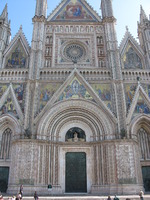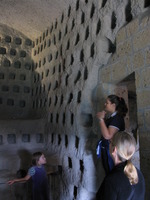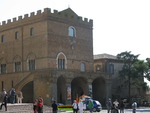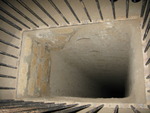On Sunday, 4th October, Julian Casey and I made the most of our day off from the General Chapter to travel by train to Orvieto, north of Rome in the region of Umbria. This city is perched on the top of a hill resulting from a volcanic eruption 100,000 years ago. It is accessed by a fenicular.
 Cathedral
Cathedral Pigeon Holes in the underground caves where homing pigeons lived and provided food for the residents.Once there, we visited the beautiful Duomo or Cathedral, St Patrick's Well and took a guided tour of the underground city. Once underground, our guide informed us there are 1200 man made caves in the area. Across the centuries, these caves have been used for people to hide from invasion, even as recenthly as during World War II. An Etruscan enclave from the Eighth Century BC, the town was destroyed by the Romans in 264BC. It became reinhabited in the Middle Ages when people began to work, but not live, in these numerous caves.
Pigeon Holes in the underground caves where homing pigeons lived and provided food for the residents.Once there, we visited the beautiful Duomo or Cathedral, St Patrick's Well and took a guided tour of the underground city. Once underground, our guide informed us there are 1200 man made caves in the area. Across the centuries, these caves have been used for people to hide from invasion, even as recenthly as during World War II. An Etruscan enclave from the Eighth Century BC, the town was destroyed by the Romans in 264BC. It became reinhabited in the Middle Ages when people began to work, but not live, in these numerous caves.
With a steady temperature throughout the year of between 14 and 15 degrees Centigrade, the caves provided an ideal location for people to make olive oil, which they did from 1300 to 1882. They also used the soft volcanic stone to make cement, which was carried out of the caves by donkeys.
Perched on the top of such a steep hill, once the town was under siege, its assailents waited until the inhabitants ran out of water. Consequently it was necessary for the residents, including the Pope, to build wells. Today there is still erosion by wind and rain requiring reinforcement of the cave area. For 20m under the town's streets, two thirds of the space is taken by these empty caves.  Papal Residence when Rome was under siege
Papal Residence when Rome was under siege Well, originally 100m deep, 80cm x 100cm with cavities on the back wall for people to use to climb down to collect water
Well, originally 100m deep, 80cm x 100cm with cavities on the back wall for people to use to climb down to collect water
